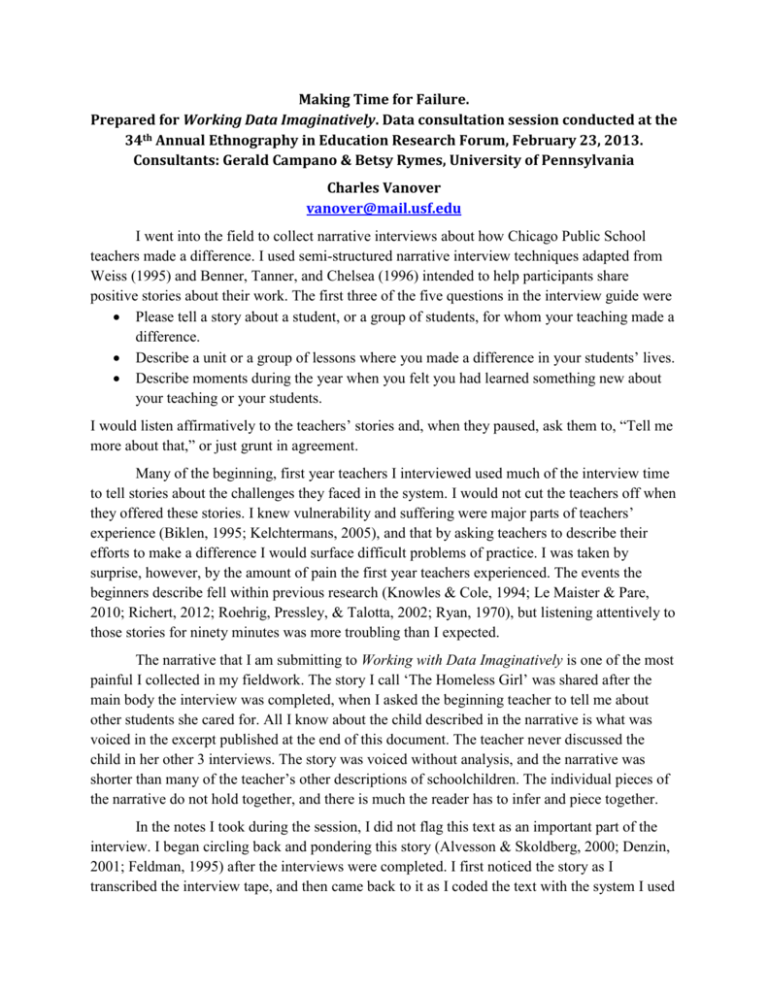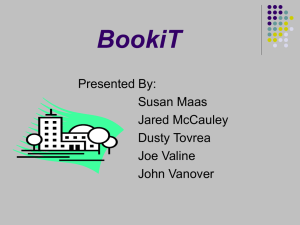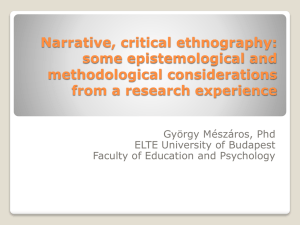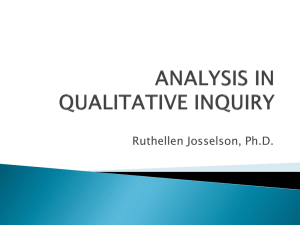2013_PENN_Makin consultation session
advertisement

Making Time for Failure. Prepared for Working Data Imaginatively. Data consultation session conducted at the 34th Annual Ethnography in Education Research Forum, February 23, 2013. Consultants: Gerald Campano & Betsy Rymes, University of Pennsylvania Charles Vanover vanover@mail.usf.edu I went into the field to collect narrative interviews about how Chicago Public School teachers made a difference. I used semi-structured narrative interview techniques adapted from Weiss (1995) and Benner, Tanner, and Chelsea (1996) intended to help participants share positive stories about their work. The first three of the five questions in the interview guide were Please tell a story about a student, or a group of students, for whom your teaching made a difference. Describe a unit or a group of lessons where you made a difference in your students’ lives. Describe moments during the year when you felt you had learned something new about your teaching or your students. I would listen affirmatively to the teachers’ stories and, when they paused, ask them to, “Tell me more about that,” or just grunt in agreement. Many of the beginning, first year teachers I interviewed used much of the interview time to tell stories about the challenges they faced in the system. I would not cut the teachers off when they offered these stories. I knew vulnerability and suffering were major parts of teachers’ experience (Biklen, 1995; Kelchtermans, 2005), and that by asking teachers to describe their efforts to make a difference I would surface difficult problems of practice. I was taken by surprise, however, by the amount of pain the first year teachers experienced. The events the beginners describe fell within previous research (Knowles & Cole, 1994; Le Maister & Pare, 2010; Richert, 2012; Roehrig, Pressley, & Talotta, 2002; Ryan, 1970), but listening attentively to those stories for ninety minutes was more troubling than I expected. The narrative that I am submitting to Working with Data Imaginatively is one of the most painful I collected in my fieldwork. The story I call ‘The Homeless Girl’ was shared after the main body the interview was completed, when I asked the beginning teacher to tell me about other students she cared for. All I know about the child described in the narrative is what was voiced in the excerpt published at the end of this document. The teacher never discussed the child in her other 3 interviews. The story was voiced without analysis, and the narrative was shorter than many of the teacher’s other descriptions of schoolchildren. The individual pieces of the narrative do not hold together, and there is much the reader has to infer and piece together. In the notes I took during the session, I did not flag this text as an important part of the interview. I began circling back and pondering this story (Alvesson & Skoldberg, 2000; Denzin, 2001; Feldman, 1995) after the interviews were completed. I first noticed the story as I transcribed the interview tape, and then came back to it as I coded the text with the system I used MAKING TIME FOR FAILURE 2 to mark the transcripts in the first round of interviews. Even though the coding for this text was not substantially different from other sections of the transcript, the analysis pushed the story into my consciousness. There were more than 100 stories about students in the interviews I conducted, however, and I focused on other narratives during the first years of the inquiry. What brought the child’s story to the surface was the process of creating ethnodramas from my fieldwork (Denzin, 2003; Kazubowski-Houston, 2010; Saldaña, 2002, 2011; SnyderYoung, 2010; Vanover, 2005; Vanover & Saldaña, 2005). I feel that there is something powerful in the text I would like to communicate to others. My questions do not focus on how to analyze the data or reduce its content to a theme, but how best, in Feldman’s (2005) term, to expand the narrative. I would like the consultants to discuss how I might flesh out the incidents the teacher describes and bring the child’s story to life. I am interested in inquiring into what I might do to produce what Tyler (1986) describes as a meditative vehicle and allow others to feel what the teacher felt when she was told the child’s family had been kicked out of their homeless shelter and had to move to the suburbs. The teacher’s part in the story had ended; the matter was now out of her hands. Data That’s Christopher. He was an interesting kid. And one—one girl who is also repeating. She lived in a homeless shelter. She was my best student—like, not academically, but behaviorally. So appropriate—never inappropriate. Never—but she missed so much school because of their living situation. There were times where she told me she couldn’t get to school because I don’t think the shelter was [near us]. So, they had to take a bus, and the school used to give them reduced fare bus cards, but, like, they were out of them. So, I would always slip her money every once in a while, just so they could get to school and back. She was already repeating 3rd grade, and she was smart. I mean, she had the skills—I just wanted her to get through and to pass, and she still is going to have to go to summer school this year which makes me so sad. I don’t know, it was just really weird. Her mother withdrew her at the end of the—withdrew her at the beginning of last week because they couldn’t even stay at their shelter anymore. They had to go somewhere in the suburbs. But, she had missed so many days—she had missed almost 50 days of school. So, and there was no way that I could pass her. No matter where she ends up next year I think maybe they will let her take the ITBS [the Chicago high stakes assessment] again. I don’t know, but I have a feeling she’s going to have to do something, you know, something’s going to have to happen before she can go to 4th grade. Which is pretty upsetting because she is such a sweet girl and, by far, my most appropriate, most behaved student and with every teacher that dealt with her. Just always, just really wonderful, respectful. I used to use exit tickets at the end of the day with my kids. ‘What did you learn about reading math and life?’ Inevitability, like her and a lot of other kids too would write, “I learned that this class is really mean to you.” She was just, she’s a doll and just a sweet girl. I learned a lot from her because other kids were very resentful of the treatment she received, but it’s like, ‘She doesn’t get this treatment for any other reason other than she always follows directions. And she always makes good choices. She always does what she thinks is best, and that she never tries to hurt someone.’ Charles Vanover vanover@mail.usf.edu MAKING TIME FOR FAILURE 3 References Alvesson, Mats, & Skoldberg, Kaj. (2000). Reflexive methodology: New vistas for qualitative research. London: Sage. Benner, Patricia E., Tanner, Christine A., & Chelsea, Catherine. (1996). Expertise in nursing practice: Caring, clinical judgment, and ethics. New York: Springer Publishing Company. Biklen, Sari Knopp. (1995). School Work: Gender and the cultural construction of teaching. New York: Teacher's College Press. Denzin, N. (2001). The reflexive interview and a performative social science. Qualitative Research, 1(1), 23-46. Denzin, N. (2003). Performance ethnography: Critical pedagogy and the politics of culture. Thousand Oaks, CA: Sage. Feldman, M. S. (1995). Strategies for interpreting qualitative data. Thousand Oaks, CA: SAGE. Feldman, M. S. (2005). Why ethnodrama, and why not?: Keynote address to the University of Michigan Narrative Institute, 2005. HTTP: XXXXXXXXXXX Kazubowski-Houston, M. (2010). Staging strife: Lessons from performing ethnography with polish Roma women. Montreal, Canada: McGill-Queen's University Press. Kelchtermans, G. (2005). Teachers' emotions in educational reforms: Self-understanding, vulnerable commitment and micropolitical literacy. Teaching and Teacher Education, 21(8), 995-1006. Knowles, J. G., & Cole, A. L. (1994). Through preservice teacher's eyes: Exploring field experiences through narrative and inquiry. New York: MacMillan. Le Maister, C., & Pare, A. (2010). Whatever it takes: How beginning teachers learn to survive. Teaching and Teacher Education, 26(559-564). Richert, A. E. (2012). What shall I do? : Confronting dilemmas of teaching in urban schools. New York: Teachers College Press. Roehrig, Alysia D, Pressley, Michael, & Talotta, Denise A. (2002). Stories of beginning teachers: First-year challenges and beyond. Notre Dame, Ind.: University of Notre Dame. Ryan, K. . (1970). Don't smile until Christmas: Accounts of the first year of teaching. Chicago: University of Chicago Press. Saldaña, J. (2002). Dramatizing data: A primer. Qualitative Inquiry, 9(2), 218-236. Saldaña, J. (2011). Ethnotheatre: Research from page to stage. Walnut Creek: Left Coast Press. Snyder-Young, D. (2010). Beyond "an Aesthetic of Objectivity": Performance ethnography, performance texts, and theatre. Qualitative Inquiry, 16(10), 883-893. Tyler, Stephen A. (1986). Post-modern ethnography: From document of the occult to occult document. In J. Clifford & G. E. Marcus (Eds.), Writing culture: The poetics and politics of ethnography (pp. 122-140). Berkeley: University of California Press. Vanover, C. (2005). Teaching the power of the word: Culturally responsive pedagogy in the Chicago Public Schools. Performance for the University of Michigan Narrative Institute. Ann Arbor. Vanover, C., & Saldaña, J. (2005). Chalkboard concerto: Growing up as a teacher in the Chicago Public Schools. In J. Saldaña (Ed.), Ethnodrama: An anthology of reality theatre. New York: Alta Mira. Charles Vanover vanover@mail.usf.edu MAKING TIME FOR FAILURE Weiss, Robert Stuart. (1995). Learning from strangers: The art and method of qualitative interview studies (1st Free Press pbk. ed.). New York: Free Press. Charles Vanover vanover@mail.usf.edu 4










